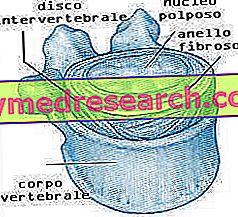| Slipped disc | Discopathy | Intervertebral disc |
Discopathy is a term used by doctors to indicate a generic alteration of the intervertebral disc, that kind of bearing interposed between a vertebra and the other with the purpose of facilitating movements and cushioning shocks.

The intervertebral discs are flexible fibrocartilaginous structures, interposed between the bodies of the vertebrae. In young people they make up 25% of the height of the entire column, but this percentage decreases significantly over the years.
The central part of the disc, called the pulpy nucleus, has a spherical shape and contains a gelatinous substance, composed of about 88% water (in the elderly this percentage falls below 70%).
The ring surrounding the nucleus pulposus is formed by a series of concentric fibrous bundles. Their special arrangement prevents the forces on the column from causing the core to escape.
During the various vertebral stresses the pulp nucleus acts as a shock absorber, distributing the loads to the fibrous ring. These continuous compressions reduce its water content, with consequent dehydration and loss of thickness. During the night, not undergoing significant forces, the pulpy nuclei rehydrate by osmosis, regaining their original thickness.
If the efforts exerted on the column are considerable and repeated, the disc undergoes a rapid process of aging and degeneration, thus giving rise to discopathy.
When following a diagnostic study, performed to ascertain the causes of back pain, the report reads the simple term "discopathy", it is not necessary to be alarmed. It is in fact a simple condition of disc suffering that is probably the basis of a pain that cannot be explained by other degenerative pathologies of vertebral structures. In other words, not noticing significant anomalies in the column, the origin of the pain is attributed to one or more disks which, on diagnostic examination, appear slightly flattened. This diagnosis is quite vague and imprecise.
The speech changes radically when we talk about degenerative discopathy or when the term is inserted in a wider context (protrusion, herniation, strong reduction in thickness, arthrosic alterations, etc.).
Over the years the intervertebral discs lose water and collapse, becoming practically shock absorbers discharges. Through MRI we can appreciate this involution and hypothesize that this is the basis of back pains not associated with sciatica. There is talk in these cases of discopathy.
The most serious consequences of discopathy are related to the reduction of the disc's cushioning capacity and to the simultaneous loss of normal relations between one vertebra and another.
The combination of these processes favors disc herniation and can lead, over the years, to the appearance of vertebral arthrosis.
These abnormalities can irritate adjacent nerve structures, triggering pain . Although back pain is the most common symptom associated with disc disease, in most cases the condition runs completely asymptomatically.
CAUSES: prolonged maintenance of static positions, such as sitting, aggravated by axial stresses such as those to which the column is subjected while driving. Other possible causes of the pathology are to be found in the normal aging process, in a sedentary lifestyle and in reducing physical performance.
The therapy of a generic discopathy is fundamentally non-invasive and based on the use of physiokinesitherapy, possibly associated with pharmacological treatment with analgesics and anti-inflammatories. Even in the most severe cases (discopathy associated with herniation) there is often a spontaneous improvement, which is favored by partial rest and rehabilitation exercises.
In the presence of discopathy it is therefore important to try not to worsen the situation through good prevention (see: back pain and prevention).
Only in the most serious cases, after the failure of conservative treatment, it is necessary to have surgery.
Discopathy associated with ...
Herniation (disc herniation): degenerative alteration of the intervertebral disc (discopathy), caused by the failure of the fibrous ring and the consequent leakage of the semifluid substance present in the nucleus. The migration of this semi-fluid content causes chemical pressures and insults to the adjacent nerve roots, triggering pain.
Often this particular type of discopathy has the act of bending forward and sideways to lift heavy objects.
Different degrees and types of disc herniation can occur:
 | DISCAL PROTRUSION: the disc in question appears more squashed than the adjacent one; the fibers that make up the fibrous ring fade, without tearing DISCAL PROLASS: the fibrous ring is fixed but the posterior longitudinal ligament can contain the nucleus pulposus DISCAL EXTRUSION: the nucleus pulposus comes out also perforating the posterior longitudinal ligament DISCAL EXPULSION: part of the herniated material is completely expelled and loses continuity with the pulpy nucleus from which it has migrated |
Reduction of the space between vertebra X and vertebra Y: it means that the intervertebral disk interposed between these two vertebrae is crushed. Thanks to MRI it is possible to recognize this generic discopathy even in an extremely early stage.
Spondylosis: defect of the vertebral arch, an anatomical structure located posteriorly. Together with the body, the vertebral arch forms a hole which, thanks to the superposition of the various vertebrae, gives rise to and protects a channel, called vertebral, in which the spinal cord is contained. Spondylolysis promotes spondylolisthesis.
Spondylolisthesis: slipping of one vertebra on the other. It can cause nerve root compressions and cause pain.
Osteoarthritis: degenerative process of the joints associated with aging. Sometimes it starts already around the third decade of life and, in an advanced stage, causes rigidity, pain and limitation of movements. Vertebral osteoarthritis is often associated with degenerative discopathy.



